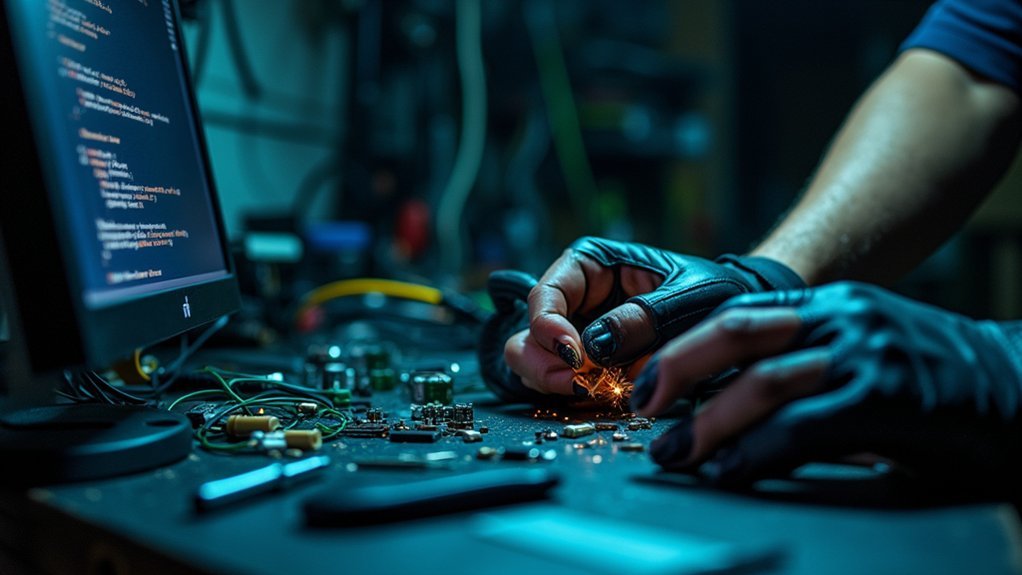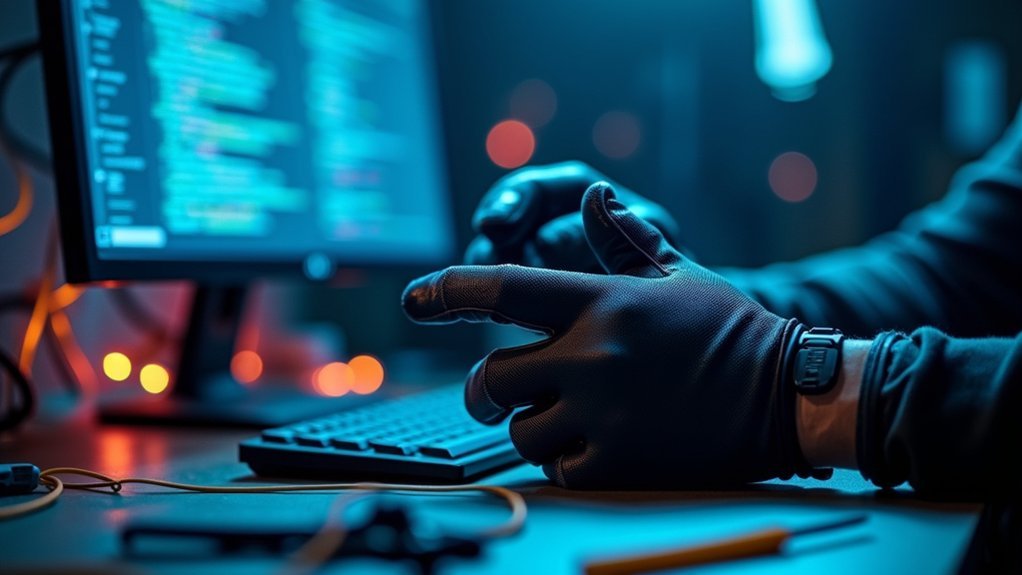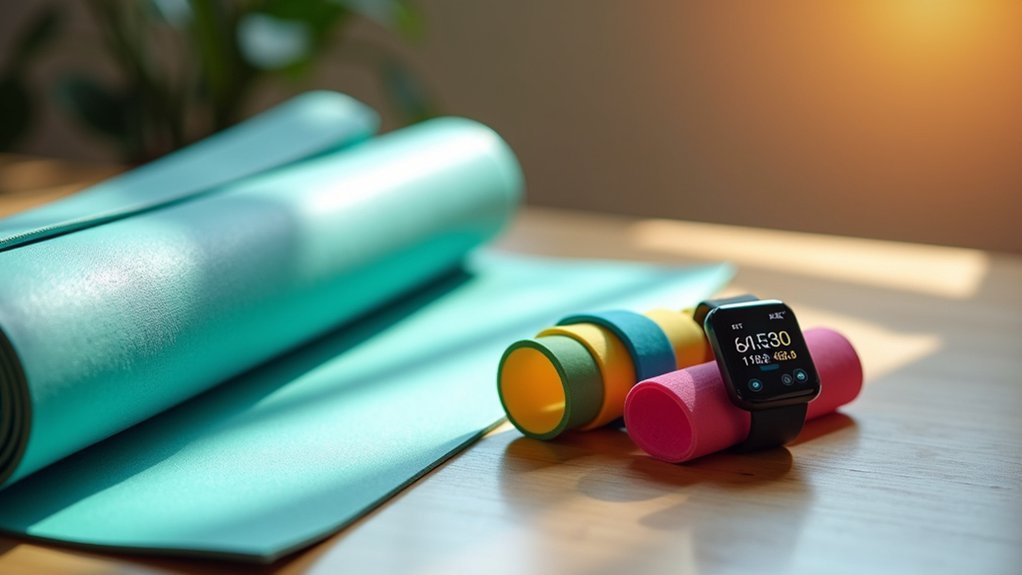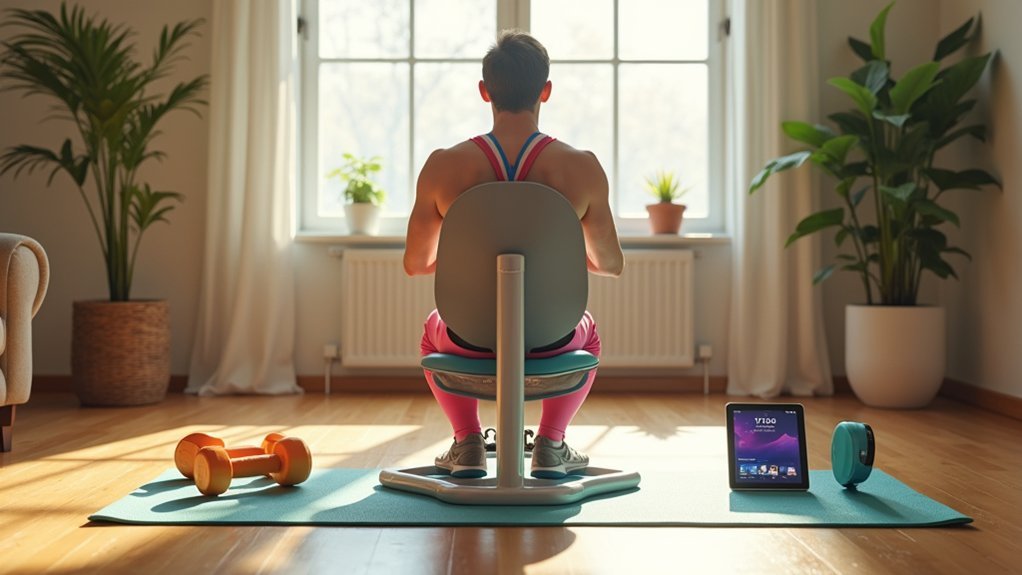You can quickly fix VR glove compatibility problems by first checking your communication protocol settings in the lucidgloves-firmware.ino file—select USB Serial for Arduino Nano or Bluetooth Serial for ESP32 boards. Next, verify you’re using the correct driver version for your specific glove model and update your firmware to the latest version. Make certain your VR games comply with OpenVR standards for proper integration with SteamVR and OpenGloves. These targeted solutions address the most common issues you’ll encounter.
Common Hardware Communication Protocol Failures

Most VR glove compatibility issues trace back to communication protocol failures that you can resolve by examining your firmware configuration.
Check your lucidgloves-firmware.ino file first, as improper settings frequently cause finger tracking malfunctions. You’ll need to select the correct communication method based on your hardware—use USB Serial for Arduino Nano boards and Bluetooth Serial for ESP32 boards like the ESP-WROOM-32.
Improper firmware settings in lucidgloves-firmware.ino cause tracking failures—choose USB Serial for Arduino Nano or Bluetooth Serial for ESP32 boards.
When finger tracking becomes unresponsive, verify that your encoding schemes match OpenGloves driver specifications.
The firmware folder contains troubleshooting guides specifically addressing board compatibility issues. Don’t overlook firmware updates, as newer versions often resolve persistent communication problems.
For custom hardware setups, confirm your communication methods align perfectly with driver requirements to prevent compatibility failures that disrupt finger tracking performance.
Software Driver Installation and Configuration Errors
After resolving hardware communication issues, software driver installation and configuration errors become the next major obstacle you’ll face with VR glove compatibility. You’ll need to verify you’re using the correct driver version for your specific VR glove model, as outdated versions cause installation failures.
| Common Issues | Solutions |
|---|---|
| Version incompatibility | Download latest driver from manufacturer |
| OS compatibility errors | Check system requirements before installation |
| Firmware conflicts | Update firmware to newest version |
Follow the step-by-step instructions in your Udcap VRGlove Product Manual V0.1 for proper software driver installation procedures. Check your operating system’s compatibility requirements beforehand to prevent configuration errors. When problems persist, consult the manual’s troubleshooting section for specific solutions. Keep your firmware updated to guarantee peak software performance.
VR Platform Integration Challenges With Steamvr and Opengloves

Once you’ve successfully installed your VR glove drivers, you’ll encounter platform-specific integration challenges that can complicate your setup process.
OpenGloves requires strict adherence to OpenVR standards, meaning compatibility issues will surface when you’re using non-OpenVR compliant games. Your VR GLOVES work seamlessly with Index controller tracking for finger curling, but you’ll face limited Force Feedback compatibility.
When integrating custom hardware with OpenGloves, you must follow specific encoding schemes and communication methods.
If you’re using LucidVR gloves, regular firmware updates guarantee peak performance with the latest VR systems. However, non-compliant games won’t recognize your finger tracking capabilities, forcing you to troubleshoot compatibility on a game-by-game basis rather than enjoying universal functionality.
Arduino and ESP32 Firmware Compatibility Solutions
When you’re working with LucidVR firmware, you’ll find it’s specifically engineered for compatibility with both Arduino Nano and ESP32 microcontrollers, giving you flexibility in choosing your hardware platform.
You can configure communication methods directly in the lucidgloves-firmware.ino file. This allows you to optimize performance by selecting between USB Serial and Bluetooth Serial options based on your specific setup requirements.
If you encounter compatibility issues, navigate to the firmware/lucidgloves-firmware folder where you’ll find extensive troubleshooting guides. These resources help you resolve common problems quickly.
The firmware currently supports multiple communication protocols, with BLE support planned for future updates. This enhancement will improve compatibility with newer devices.
You can follow the detailed configuration instructions to address most Arduino and ESP32 compatibility challenges effectively.
Tracking Accuracy Calibration and Performance Optimization
For ideal VR glove performance, you’ll need to fine-tune your tracking accuracy through proper calibration settings in the lucidgloves-firmware.ino file. Adjust these configurations to match your specific requirements and hardware setup.
First, verify you’re using tested boards like Arduino Nano or ESP-WROOM-32, which consistently deliver reliable tracking accuracy across various configurations.
Tested boards like Arduino Nano and ESP-WROOM-32 provide consistent, reliable tracking accuracy for optimal VR glove performance.
Keep your firmware files updated regularly, as these updates include performance improvements that directly enhance tracking capabilities.
When calibrating, work in a stationary environment to minimize interference and maximize finger tracking precision during VR sessions. This controlled setting allows for more accurate sensor readings and better overall performance.
If you encounter tracking accuracy issues, consult the troubleshooting guides in your firmware documentation. These resources provide targeted solutions for resolving performance problems effectively.
Real-Time Troubleshooting for Multiple VR Headset Systems
While working with different VR headset systems, you’ll encounter unique compatibility challenges that require specific troubleshooting approaches tailored to each platform.
First, verify your VR gloves match your headset by checking SenseGlove’s compatibility documentation for Oculus Quest 2 or HTC Vive Pro systems. Update firmware using files from the firmware/lucidgloves-firmware folder to resolve headset-specific issues.
For Bluetooth-enabled ESP32 boards, configure Bluetooth Serial communication properly in the lucidgloves-firmware.ino file. When connectivity problems persist, switch to USB Serial with Arduino Nano for stable connections during troubleshooting. This guarantees your VR controllers maintain consistent tracking data flow.
Join the LucidVR Discord server for real-time support from experienced users who’ve solved similar multi-headset compatibility challenges across different platforms.
Frequently Asked Questions
What Are the Best VR Haptic Gloves?
You’ll find SenseGlove Nova and Nova 2 are top choices, offering advanced force feedback and vibrotactile cues. They’re priced at €4,499 and €5,999 respectively, providing excellent finger tracking accuracy for immersive experiences.
Do VR Gloves Work?
Yes, VR gloves work effectively when properly calibrated and compatible with your system. You’ll experience enhanced immersion through finger tracking and haptic feedback, though performance varies depending on your specific VR headset and applications.
In Summary
You’ve tackled the most critical VR glove issues that’ll get you back to immersive experiences quickly. By addressing hardware protocols, updating drivers, configuring platform integrations, and optimizing firmware, you’ll eliminate most compatibility headaches. Don’t forget to calibrate your tracking regularly and keep troubleshooting tools handy for multiple headset setups. With these solutions in your toolkit, you’ll spend less time fixing problems and more time enjoying seamless hand tracking in VR.





Leave a Reply